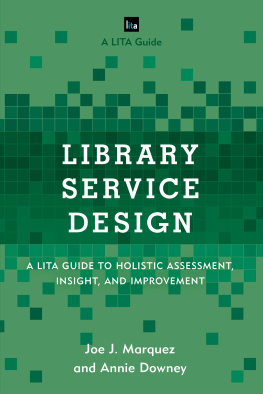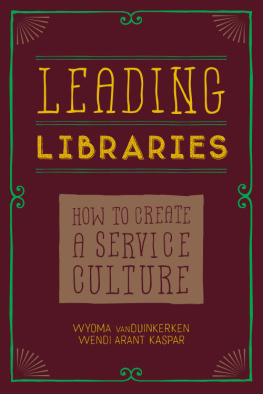Customer Service in Libraries
Best Practices
Edited by Charles Harmon and Michael Messina

THE SCARECROW PRESS, INC.
Lanham Toronto Plymouth, UK
2013
Published by Scarecrow Press, Inc.
A wholly owned subsidiary of The Rowman & Littlefield Publishing Group, Inc.
4501 Forbes Boulevard, Suite 200, Lanham, Maryland 20706
www.rowman.com
10 Thornbury Road, Plymouth PL6 7PP, United Kingdom
Copyright 2013 by Scarecrow Press, Inc.
All rights reserved. No part of this book may be reproduced in any form or by any electronic or mechanical means, including information storage and retrieval systems, without written permission from the publisher, except by a reviewer who may quote passages in a review.
British Library Cataloguing in Publication Information Available
Library of Congress Cataloging-in-Publication Data
Customer service in libraries : best practices / edited by Charles Harmon, Michael Messina.
pages cm
Includes bibliographical references and index.
ISBN 978-0-8108-8748-0 (pbk.) ISBN 978-0-8108-8749-7 (ebook) 1. Public services (Libraries)United States. 2. Customer servicesUnited States. I. Harmon, Charles, 1960- II. Messina, Michael.
Z711.C88 2013
025.50973dc23 2012044861
 The paper used in this publication meets the minimum requirements of American National Standard for Information SciencesPermanence of Paper for Printed Library Materials, ANSI/NISO Z39.48-1992. Printed in the United States of America.
The paper used in this publication meets the minimum requirements of American National Standard for Information SciencesPermanence of Paper for Printed Library Materials, ANSI/NISO Z39.48-1992. Printed in the United States of America.
Contents
Introduction
Audra Caplan
Former President of the Public Library Association
L ast week, the business section of my local newspaper, the Baltimore Sun , featured an article on how giant home-improvement chains are focusing on building customer service initiatives. The article specifically cited Home Depot and Lowes. I had been in a Home Depot recently and expected to have the same disorienting experience I always have when shopping there, but much to my astonishment, the store had a sales representative at the end of almost every aisle. I was asked numerous times if I needed assistance, and when I responded that I did, the person who helped me walked me to the location I needed and then made recommendations for products based on my specific needs. Needless to say, I was a very happy customer and will return with much less trepidation. It turns out that this is the result of a major initiative called Customers First. Home Depot employees have been retrained and are required to spend 60% of their time helping customers. Their previous focus had been on stocking shelves and cleaning. Over the last year, the price of their shares has increased 80%, and their sales have gone up dramatically. At Lowes, the company outfitted all of its stores with wi-fi and supplied 25 iPhones for associates to help customers with their shopping. Now customers can look up required materials and give accurate dimensions so that products can be identified immediately and bought on the spot. Both these initiatives are examples of best practices in customer service and can easily be translated to what we do in libraries.
In my opinion, creating a culture of excellent customer service in libraries is the most important factor in our future survival. In his article Am I Obsolete? How Customer Service Principles Ensure the Librarys Relevance, Mark Bernstein suggests that an ever-increasing number of people will question whether libraries will be necessary in the future as the use of technology expands and increases. He states that how we can ensure that we and our libraries do not become obsolete is to provide customer service: Without the service mission and the people who provide that service libraries are nothing more than a warehouse.
Ask employees of any public library why the library exists, and most of them are likely to say that were here to serve our patrons/customers. Still, how we define and deliver customer service differs widely from one library to another. Some believe that the quality of the work we now provide is enough, while others believe that customer service is the most important thing that we do, and it is provided at every level of the organization. Exceptional libraries demonstrate their commitment to their customers in everything that they do. The first gauge of having a customer service culture goes beyond individual encounters to building mission, vision, values, and policies around assessing and fulfilling customers needs. The first sentence in the Brooklyn Public Librarys customer service policy states, Customer Service is an integral part of the Brooklyn Public Librarys service to Brooklyns diverse population. The policy then proceeds to lay out all of the tenets that define excellent customer service that the staff will provide.
Strangely, great customer service continues to be the exception rather than the rule. Generally, I am unable to get through a day without experiencing a bad customer service encounter. I know from my 32 years of working in public libraries that we are just as capable of providing poor customer service as any other service agency.
In this age of fast-paced change, providing superior customer service becomes more and more challenging. To survive, libraries must provide service that reflects customers changing expectations and needs. More than ever, our customers can now choose where they go for information, and the library is likely not to be the first choice. I have heard from library directors and librarians in all types of libraries that in recent years that there has been a decline in the number of reference questions they are recording. Customers have more options than ever before and less loyalty. They want services fast, easily accessible, around the clock, in person, online, and with value added from whoever will provide it to them. We have to find a way to keep our customers, and that means that we must provide a more satisfactory experience than our competition. Moreover, if we dont provide that experience, then e-mail and social networking opportunities make it easy for customers to broadcast their dissatisfaction. Of course, if we do provide an exceptional experience, we can touch thousands of people through these same channels. A recent post on Facebook came from a young man whose grandmother was dying and had expressed a craving for Paneras clam chowder. The man called his local Panera on a Monday, knowing that the chowder was served only on Fridays. The manager responded quickly, saying that she would make some that day to fill this request. She provided the soup and an unexpected box of cookies free of charge. You can imagine how appreciative the family was for this service. When I observed the post, it had already received 678,824 likes on Facebook in the space of just 2 days.
Since I have been given the opportunity to write this introduction, I am going to take the liberty to use it as a bully pulpit. I would like to suggest some basic concepts that I believe ensure exceptional customer service in organizations.
Start at the top. If the CEO, director, or administrators do not understand that quality service is a basic performance expectation of all members of the staff, then it will not permeate the rest of the organization. The entire organization must be focused on what the customer wants. Customer feedback should be taken seriously and reviewed in a positive and nondefensive manner, and changes should be implemented if the feedback improves service. For this culture to thrive, the administration must have the passion to communicate this message throughout the organization.












 The paper used in this publication meets the minimum requirements of American National Standard for Information SciencesPermanence of Paper for Printed Library Materials, ANSI/NISO Z39.48-1992. Printed in the United States of America.
The paper used in this publication meets the minimum requirements of American National Standard for Information SciencesPermanence of Paper for Printed Library Materials, ANSI/NISO Z39.48-1992. Printed in the United States of America.